 |
| Meow Wolf’s artist-designed interactive experience in Santa Fe is a fine example of the design of an experience. |
Designers must be able to design objects (such as cars, clothes, and home furnishings), information (digital games, films, websites, and blogs), environments (interiors, buildings, and gardens), and experiences (multi-media performances, museums, theme parks, airports, and other public spaces) that are not only functional but also attractive and engaging.
Daniel Pink initially brought widespread attention to design thinking through his engaging exploration and support in his book, A Whole New Mind, first published in 2005. His fundamental belief is that those who use the right side of their brains, the side that is emotional and creative, will be best suited to attain the needed 21st century skills of creativity and innovation, critical thinking and problem solving, communication, and collaboration.
Another major proponent of design thinking is IDEO, a self-described “global design consultancy that createsimpact through design.” Their approach to design thinking is a brainstorming process that involves working collaboratively though the five key stages: empathize, define, ideate, prototype, and test. Space doesn’t allow me to expand on these here, but there are numerous exemplary educational resources for design thinking available on the internet.
You can download IDEO’s free Design Thinking Toolkit for Educators at bit.ly/2MT7uoi. You can find “An Educator’s Guide to Design Thinking” from the Stanford D. School at stanford.io/2WmzLGJ. “Design Thinking in Education” from Harvard University’s Teaching and Learning Lab is another free online resource, found at bit.ly/2Wlx2NT. To learn more, we invite you to explore the articles and studio lessons in this issue. After, all, who can better teach design thinking than art teachers?
View this article in the digital edition.



